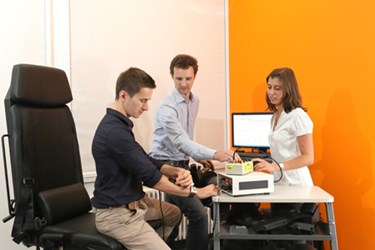Paralyzed Rat Walks Again Thanks To Electrical Stimulation
By Chuck Seegert, Ph.D.

Completely paralyzed rats can be made to walk again using newly developed control systems from Swiss researchers. The game-changing technology may begin clinical trials as soon as next summer.
Electrical impulses control our bodies as they travel up and down tracts of neurons — from the brain to extremities and everything else in between. Deep brain stimulation helps people with neurodegenerative diseases control tremors, while transcutaneous electrical nerve stimulation (TENS) may help control chronic pain. Efforts to harness the effects of electricity on damaged neurons like those seen in paraplegics have been minimally successful to date, but cutting edge research from École Polytechnique Fédérale de Lausanne (EPFL) may change that.
Taking rats whose spinal cords had been completely severed, the team developed a system to stimulate the cord, effectively inducing the rat to walk again, according to a recent press release.
“We have complete control of the rat’s hind legs,” said EPFL neuroscientist Grégoire Courtine, in the press release. “The rat has no voluntary control of its limbs, but the severed spinal cord can be reactivated and stimulated to perform natural walking. We can control in real-time how the rat moves forward and how high it lifts its legs.”
The results of the team’s work were recently published in a study in Science Translational Medicine. Their report discusses animals performing up to 1,000 successive steps without failure in one scenario. In another experiment, the rats were induced to climb staircases that had steps of various heights and lengths.
The system that makes this performance possible includes an implanted electrode system that interacts with the spinal cord through multiple, closely adjacent leads. These leads stimulate the spinal cord and, consequently, the muscles. To control these stimuli, real-time calculations are performed that adjust the animal’s leg kinematics to deal with upcoming obstacles, according to the study.
The height the limbs are lifted is directly related to electrical frequency, which is determined by many factors. Using 14 infrared cameras, two video cameras, and markers on the body, the movements are monitored and synchronized — making intelligent assistance possible.
“Simple scientific discoveries about how the nervous system works can be exploited to develop more effective neuroprosthetic technologies,” said co-author and neuroengineer Silvestro Micera, in the press release. “We believe that this technology could one day significantly improve the quality of life of people confronted with neurological disorders."
The team plans to begin clinical studies with patients who have suffered incomplete spinal chord injuries. This work may begin as soon as next summer.
Research into helping patients with various levels of paralysis is being initiated on multiple fronts. Some researchers are striving to use the patient’s imagination to drive the stimulation of paralyzed muscles. Others have developed exoskeletons that assist patient kinematics.
Image Credit: © 2014 Alain Herzog / EPFL
